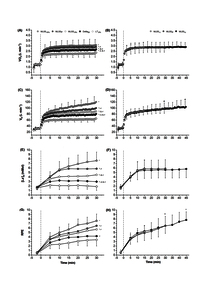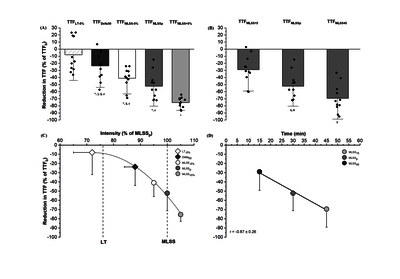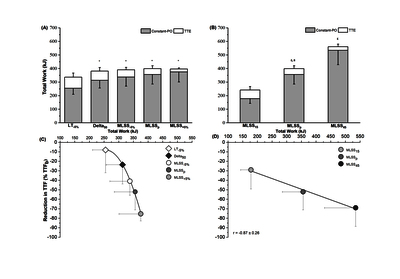Fullerton, Madison M, Passfield, Louis, MacInnis, Martin J., Iannetta, Danilo, Murias, Juan M (2021) Prior exercise impairs subsequent performance in an intensity- and duration-dependent manner. Applied Physiology, Nutrition, and Metabolism, . ISSN 1715-5312. (doi:10.1139/apnm-2020-0689) (KAR id:87025)
|
PDF
Author's Accepted Manuscript
Language: English |
|
|
Download this file (PDF/244kB) |
Preview |
| Request a format suitable for use with assistive technology e.g. a screenreader | |
|
Image (JPEG) (Fig.1)
Supplemental Material
Language: English |
|
|
Download this file (Image (JPEG)/1MB) |
![[thumbnail of Fig.1]](https://kar.kent.ac.uk/87025/2.hassmallThumbnailVersion/APNM%20Fig.1.jpg)  Preview |
| Request a format suitable for use with assistive technology e.g. a screenreader | |
|
Image (JPEG) (Fig.2)
Supplemental Material
Language: English |
|
|
Download this file (Image (JPEG)/951kB) |
![[thumbnail of Fig.2]](https://kar.kent.ac.uk/87025/3.hassmallThumbnailVersion/APNM%20Revised%20Fig.2.jpg)  Preview |
| Request a format suitable for use with assistive technology e.g. a screenreader | |
|
Image (JPEG) (Fig.3)
Supplemental Material
Language: English |
|
|
Download this file (Image (JPEG)/863kB) |
![[thumbnail of Fig.3]](https://kar.kent.ac.uk/87025/4.hassmallThumbnailVersion/APNM%20Revised%20Fig.3.jpg)  Preview |
| Request a format suitable for use with assistive technology e.g. a screenreader | |
|
Image (JPEG) (Fig.4)
Supplemental Material
Language: English |
|
|
Download this file (Image (JPEG)/911kB) |
![[thumbnail of Fig.4]](https://kar.kent.ac.uk/87025/5.hassmallThumbnailVersion/APNM%20Fig.4.jpg)  Preview |
| Request a format suitable for use with assistive technology e.g. a screenreader | |
| Official URL: https://doi.org/10.1139/apnm-2020-0689 |
|
Abstract
Prior constant-load exercise performed for 30-min at or above maximal lactate steady state (MLSSp) significantly impairs subsequent time-to-task failure (TTF) compared with TTF performed without prior exercise. We tested the hypothesis that TTF would decrease in relation to the intensity and the duration of prior exercise compared to a baseline TTF trial. Eleven individuals (6 men, 5 women, 28 ± 8 yrs) completed the following tests on a cycle ergometer (randomly assigned after MLSSp was determined): i) a ramp-incremental test, ii) a baseline TTF trial performed at 80% of peak power (TTFb), iii) five 30-min constant-PO rides at 5% below lactate threshold (LT-5%), halfway between LT and MLSSp (Delta50), 5% below MLSSp (MLSS-5%), MLSSp, and 5% above MLSSp (MLSS+5%), and iv) 15- and 45-min rides at MLSSp (MLSS15 and MLSS45, respectively). Each condition was immediately followed by a TTF trial at 80% of peak power. Compared to TTFb (330 ± 52s), there was 8.0 ± 24.1, 23.6 ± 20.2, 41.0 ± 14.8, 52.2 ± 18.9, and 75.4 ± 7.4% reduction in TTF following LT-5%, Delta50, MLSS-5%, MLSSp, and MLSS+5%, respectively. Following MLSS15 and MLSS45 there were 29.0 ± 20.1 and 69.4 ± 19.6% reductions in TTF, respectively (P <0.05). It is concluded that TTF is reduced following prior exercise of varying duration at MLSSp and at submaximal intensities below MLSS. Novelty: •Prior constant-PO exercise, performed at intensities below MLSSp, reduces subsequent TTF performance. •Subsequent TTF performance is reduced in a linear fashion following an increase in the duration of constant-PO exercise at MLSSp.
| Item Type: | Article |
|---|---|
| DOI/Identification number: | 10.1139/apnm-2020-0689 |
| Uncontrolled keywords: | Performance, exercise intensity domains, maximal lactate steady state, time to task failure, exercise tolerance, fatigue |
| Institutional Unit: | Schools > School of Natural Sciences > Sports and Exercise Science |
| Former Institutional Unit: |
Divisions > Division of Natural Sciences > Sport and Exercise Sciences
|
| Depositing User: | Louis Passfield |
| Date Deposited: | 09 Mar 2021 09:56 UTC |
| Last Modified: | 22 Jul 2025 09:05 UTC |
| Resource URI: | https://kar.kent.ac.uk/id/eprint/87025 (The current URI for this page, for reference purposes) |
- Link to SensusAccess
- Export to:
- RefWorks
- EPrints3 XML
- BibTeX
- CSV
- Depositors only (login required):


 https://orcid.org/0000-0001-6223-162X
https://orcid.org/0000-0001-6223-162X Altmetric
Altmetric Altmetric
Altmetric
